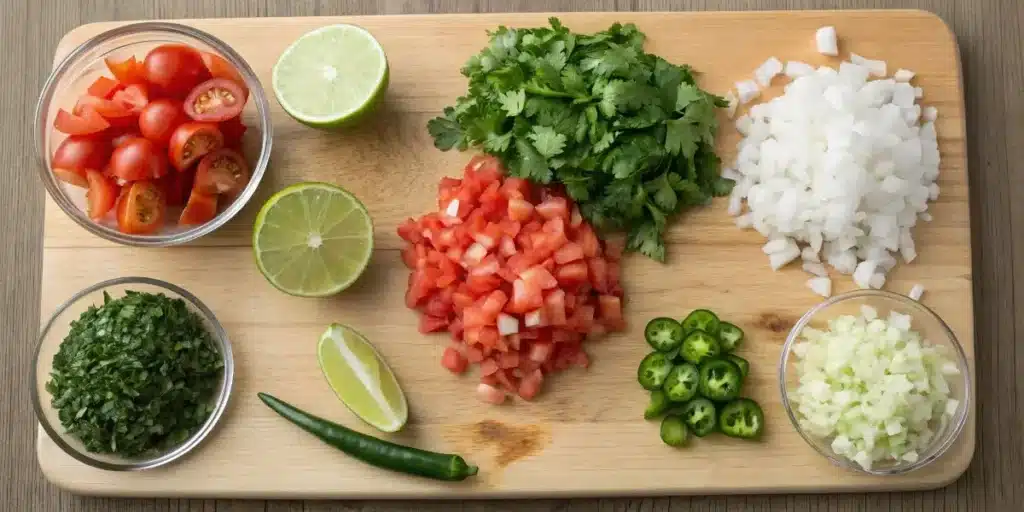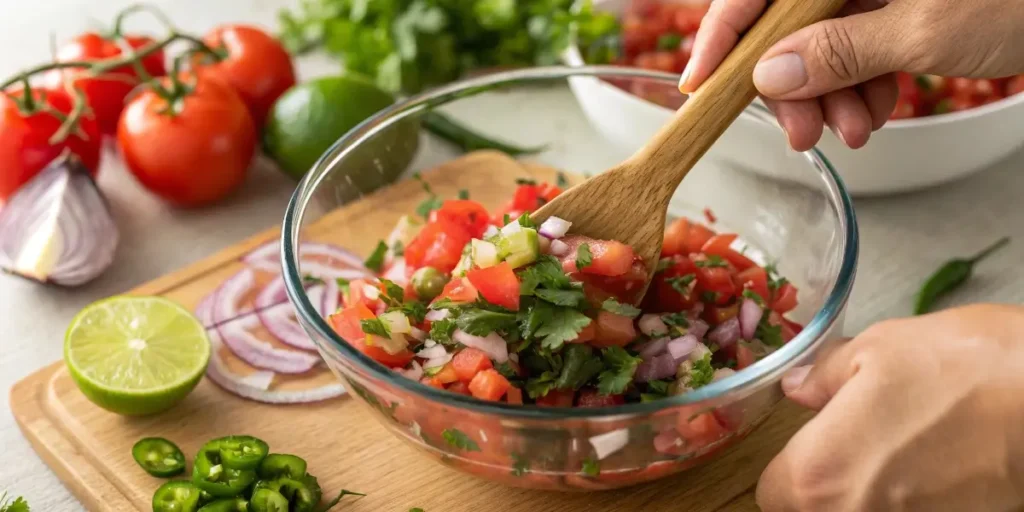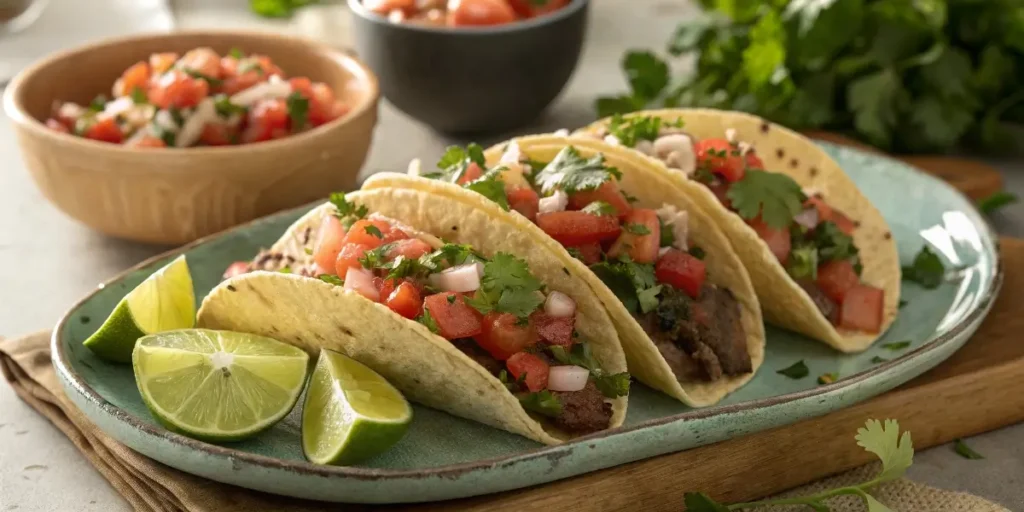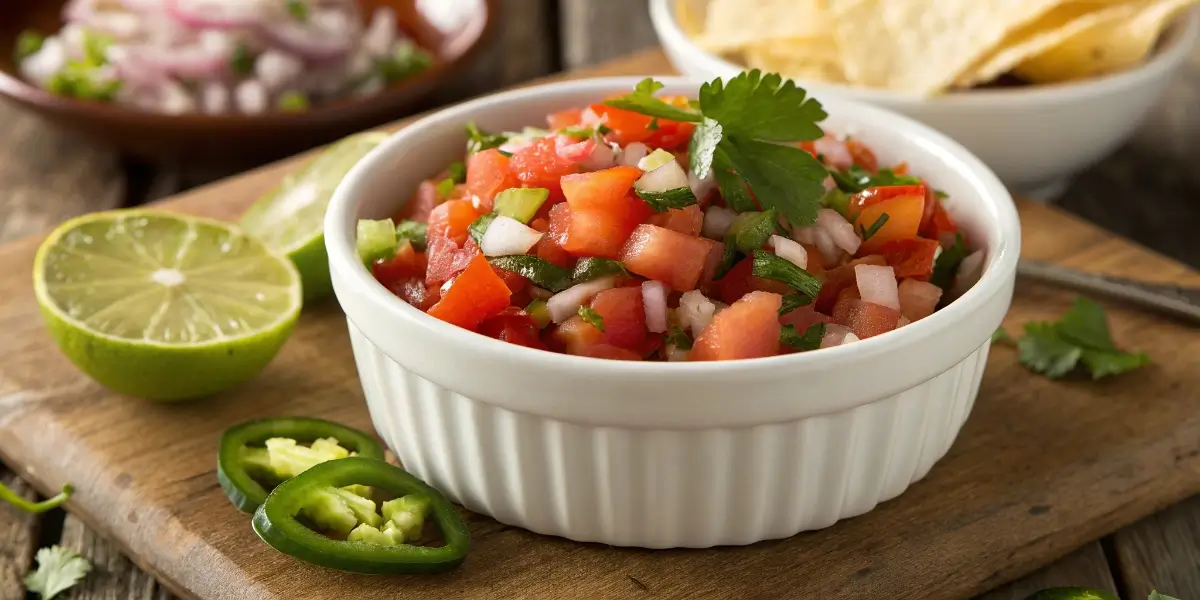Authentic Pico de Gallo Recipe – The Best Fresh Mexican Salsa
If you’ve ever tasted fresh Mexican food, you’ve likely fallen in love with the bold and zesty flavor of pico de gallo. This traditional salsa isn’t just a side dish—it’s the heart of Mexican cuisine. In this guide, we’ll explore everything from choosing the right ingredients to balancing the flavors perfectly, ensuring your pico bursts with freshness in every bite. You’ll also learn pro tips, storage secrets, and creative ways to enjoy it with your favorite dishes. And yes, this recipe is naturally vegan, gluten-free, and free from alcohol or pork.
Table of Contents
Understanding the Pico de Gallo Recipe
What Is Pico de Gallo and Why It’s a Mexican Classic
Pico de gallo, also called salsa fresca or salsa bandera (“flag salsa”), is a fresh, chunky Mexican condiment made with tomatoes, onions, cilantro, lime juice, jalapeños, and salt. Unlike cooked salsas, it’s made with raw, finely chopped ingredients that deliver a crisp, bright, and refreshing flavor. Its name, meaning “rooster’s beak,” comes from the way people originally ate it—pinching small bites between their fingers.
This recipe has become a staple across Mexican homes because of its simplicity and versatility. Whether you’re topping tacos, grilled meats, or enjoying it with tortilla chips, pico de gallo adds instant brightness and balance. It’s naturally low in calories, packed with nutrients, and pairs beautifully with just about any savory dish.
Difference Between Pico de Gallo and Salsa Fresca
While the terms pico de gallo and salsa fresca are often used interchangeably, there’s a subtle distinction. Pico de gallo has a chunkier texture, where each ingredient is visible and diced rather than blended. Salsa fresca or salsa roja, on the other hand, can include blended or pureed tomatoes for a smoother consistency.
Here’s a quick comparison table for clarity:
| Feature | Pico de Gallo | Salsa Fresca (Red Salsa) |
|---|---|---|
| Texture | Chunky, diced | Smooth or semi-blended |
| Cooking Method | Raw, uncooked | Often roasted or blended |
| Main Use | Topping or side | Dip or sauce |
| Shelf Life | Short (fresh only) | Longer when cooked |
Pico de gallo’s raw freshness makes it perfect for health-conscious eaters and those who prefer clean, natural flavors. You don’t need fancy tools—just a sharp knife, a bowl, and a few fresh vegetables.
Learn more about pairing dips with Mexican dishes in Mexican Street Corn Dip with Cream Cheese.
Essential Ingredients for Pico de Gallo
Fresh Ingredients List and Ideal Ratios
To make the best pico de gallo recipe, it all starts with fresh ingredients. The flavor depends entirely on quality and balance. Here’s a simple, authentic ingredient list you can rely on:
| Ingredient | Quantity | Notes |
|---|---|---|
| Roma tomatoes | 4 medium | Firm and ripe for a juicy texture |
| White onion | ½ medium | Offers a crisp, clean bite |
| Fresh cilantro | ¼ cup | Adds a fragrant, citrusy aroma |
| Jalapeño pepper | 1 medium | For mild to medium heat; adjust as desired |
| Fresh lime juice | 1–2 tbsp | Enhances brightness and balances acidity |
| Sea salt | ½ tsp or to taste | Brings out the flavors naturally |
These ingredients create the foundation of a classic pico de gallo. The ideal ratio is about 2 parts tomato to 1 part onion, with lime and cilantro as flavor enhancers. Avoid watery or overripe tomatoes, which can make your salsa soupy.

How to Choose the Freshest Tomatoes, Onions, and Jalapeños
Choosing high-quality produce is the real secret behind a flavorful pico. Let’s break it down:
Tomatoes: Go for Roma or plum tomatoes because they’re firm and less watery. Their meaty texture helps your pico hold its shape. If you can’t find them, cherry tomatoes work well as an alternative.
Onions: A white onion gives a sharp but clean flavor that blends perfectly with lime and jalapeño. If you prefer a milder taste, you can soak diced onions in cold water for 10 minutes before mixing them in.
Jalapeños: Fresh jalapeños should be bright green and firm to the touch. Slice one open—if the seeds are pale and firm, it’s fresh. For a milder pico, remove the seeds and ribs before dicing.
Cilantro: Look for vibrant green leaves without yellow spots. Avoid bunches that smell musty. Fresh cilantro adds that authentic Mexican aroma no bottled herb can replace.
Limes: The perfect lime is heavy for its size and slightly soft when squeezed. Avoid dull, dry ones—fresh lime juice is key to a crisp, balanced flavor.
Discover great ideas like 5 Ingredient Guacamole Recipe to pair with your pico de gallo for a complete appetizer spread.
How to Make Pico de Gallo Step-by-Step
Preparing the Vegetables and Mixing Like a Pro
Now that your fresh ingredients are ready, let’s bring them together. Making an authentic pico de gallo recipe is all about precision and balance. You don’t need fancy equipment—just a sharp knife, a cutting board, and a mixing bowl.
Step-by-step method:
- Dice the tomatoes – Cut them into small, even cubes about ¼ inch thick. If they’re too juicy, remove the seeds to keep your pico firm.
- Chop the onion – Finely dice it to the same size as the tomatoes. This helps ensure every bite has balanced flavor.
- Prepare the jalapeño – Slice it lengthwise, remove the seeds and white ribs (for less heat), then dice finely.
- Chop cilantro – Use just the leaves and tender stems, chopping roughly for that burst of green flavor.
- Mix it all together – In a bowl, combine tomatoes, onions, jalapeño, and cilantro.
- Add lime juice and salt – Start with 1 tablespoon of lime juice and ½ teaspoon of sea salt. Mix gently with a spoon.
- Taste and adjust – If it needs more acidity, add a squeeze of lime; for a stronger punch, sprinkle extra salt.
Your finished pico should be vibrant, lightly juicy, and bursting with aroma. It’s best served right away, but you can chill it for 15 minutes to let the flavors meld naturally.

Adjusting Flavors: The Secret to the Best Pico de Gallo
Flavor adjustment is what separates a good pico from a great one. Here’s what to remember:
- Too bland? Add a touch more lime juice and a pinch of salt.
- Too spicy? Mix in extra diced tomato to balance the heat.
- Too watery? Drain the mixture briefly before serving or use firmer tomatoes next time.
- Too sour? A pinch of sugar (just a tiny bit) can round off the acidity without making it sweet.
Chef tip: Always taste your pico after it rests for a few minutes. The flavors evolve as the lime penetrates the vegetables. That’s when you’ll know if it needs any adjustments.
Don’t miss our Elote Pasta Salad Recipe for another fresh, colorful dish that complements your pico beautifully.
Chef Tips – Secrets for the Best Pico de Gallo Recipe
Balancing Flavor with Salt, Lime, and Cilantro
The magic behind a memorable pico de gallo recipe is balance—each ingredient has a purpose, and mastering that harmony makes all the difference. Salt draws out moisture and intensifies taste, lime juice adds brightness and acidity, while cilantro brings an unmistakable earthy fragrance.
To balance your flavors like a chef:
- Use coarse sea salt instead of table salt—it enhances flavor gradually and prevents over-salting.
- Add lime juice in stages. Start with one tablespoon, then adjust after tasting. Too much lime can make your pico bitter or soggy.
- Don’t overdo the cilantro. A quarter cup is plenty. Too much can overpower your dish and make it taste grassy.
Here’s a quick ratio reminder:
| Flavor Element | Role | Ideal Amount (per 4 tomatoes) |
|---|---|---|
| Salt | Enhances flavor | ½ tsp (adjust to taste) |
| Lime Juice | Adds tang and moisture | 1–2 tbsp |
| Cilantro | Adds aroma and freshness | ¼ cup chopped |
Pro tip: Mix your lime juice and salt first, then pour that over your chopped ingredients. This method helps distribute flavor evenly without bruising the tomatoes.
Common Mistakes to Avoid When Making Pico de Gallo
Even though pico is simple, small missteps can dull its brightness. Avoid these common errors:
- Using overripe tomatoes: They release too much water and make your pico soupy. Always choose firm, meaty tomatoes like Roma.
- Skipping the salt rest: After mixing, let your pico rest for at least 10 minutes before serving. This gives time for the salt to draw out juices and marry the flavors.
- Using bottled lime juice: Fresh lime juice is non-negotiable. Bottled versions often have preservatives that change the flavor.
- Overmixing: Gently fold ingredients rather than stirring aggressively to keep the texture crisp.
- Ignoring proportion: Balance your ingredients; too much onion or jalapeño can overpower the delicate tomato-cilantro combo.
Looking for inspiration? Try Authentic Spanish Rice as the perfect pairing for your fresh pico—it’s a classic Mexican meal combo.
Regional and International Variations
Pico de Gallo Recipe Across Mexico – Yucatán to Baja
While the pico de gallo recipe follows a simple base, each region in Mexico adds its own touch to reflect local ingredients and taste preferences. From the coastal towns of Baja to the Yucatán Peninsula, you’ll find delightful twists on this classic.
- Baja California Pico: Often includes diced avocado or mango for a fresh, tropical note. It pairs beautifully with fish tacos or grilled shrimp.
- Yucatán-Style Pico: Uses a sharper onion flavor—typically red onion—and may feature habanero peppers instead of jalapeños for more heat.
- Central Mexico Pico: The traditional version you’ll find at family gatherings—Roma tomatoes, white onion, cilantro, jalapeño, lime, and salt.
- Northern Mexico Variation: Sometimes corn or diced cucumber is added for texture, making it heartier for barbecues or taco fillings.

Each version remains true to its roots: colorful, crisp, and bursting with natural flavor. What makes pico special is its ability to adapt while keeping its refreshing essence intact.
How to Make Pico de Gallo in the UK: Ingredient Substitutes
If you’re outside of Mexico—say in the UK—you can still make authentic pico de gallo with locally available ingredients. Here’s how:
| Mexican Ingredient | UK Substitute | Why It Works |
|---|---|---|
| Roma tomatoes | Vine tomatoes | Firm, less watery, and similar flavor |
| White onion | Brown or yellow onion (soaked) | Similar bite; soak to reduce sharpness |
| Jalapeño pepper | Green chili or serrano | Provides the same level of heat |
| Fresh lime | Lemon with a dash of vinegar | Offers acidity and freshness |
| Cilantro | Fresh coriander | Same herb—different name |
If you can’t find fresh chilies, opt for a few drops of chili-infused oil for a gentle heat kick. Avoid pickled jalapeños, as they alter the flavor balance. And when it comes to limes, fresh is always best—don’t rely on bottled juice for this dish.
For another UK-friendly Mexican recipe, check out Cilantro Lime Rice in a Rice Cooker—it’s the perfect side for your pico-topped tacos or burrito bowls.
Serving Ideas and Pairings
Perfect Dishes to Serve with Pico de Gallo
A vibrant pico de gallo recipe can transform any meal from simple to sensational. Because it’s fresh, tangy, and slightly spicy, it pairs perfectly with both traditional Mexican dishes and lighter modern meals.
Here are a few pairing ideas to get you started:
| Dish | Why It Works |
|---|---|
| Tacos (any type) | The freshness of pico cuts through the richness of fillings like grilled chicken, steak, or fish. |
| Grilled meats | It adds color and acidity to dishes like grilled chicken, beef, or lamb. |
| Rice bowls and burritos | Pico gives an instant lift to hearty rice dishes or burrito fillings. |
| Scrambled eggs or omelets | For a bright, zesty breakfast, spoon pico on top of eggs instead of ketchup or hot sauce. |
| Tortilla chips or flatbreads | Classic party-style dip everyone loves—simple and satisfying. |
The beauty of pico is that it enhances, not overpowers, other dishes. Its clean, raw taste adds freshness wherever you use it. Try spooning a little over baked fish or pairing it with roasted vegetables for a colorful side.
Creative Ways to Use Leftover Pico de Gallo
Got some leftover pico in the fridge? Don’t let it go to waste. There are plenty of clever and tasty ways to reuse it:
- Mix it into avocado mash for an instant chunky guacamole.
- Top your grilled corn with pico and a sprinkle of cheese for a lighter version of elote.
- Stir into cooked quinoa or rice for a fast, flavorful salad.
- Use as a topping for baked potatoes to replace sour cream and butter with something fresh and healthy.
- Blend lightly to create a smooth salsa for dipping if you prefer a saucier texture.
Pro tip: Avoid reheating pico; it’s meant to stay raw and crisp. If you want warmth, add it on top of freshly cooked food so it stays bright but slightly warmed through from the steam.
Don’t miss our Mexican Beef and Rice Skillet for a hearty meal that pairs beautifully with fresh pico de gallo.
Storing and Marinating Pico de Gallo
Does Pico de Gallo Need to Marinate? Flavor and Texture Tips
A key question for anyone making pico de gallo recipe at home is whether it should marinate before serving. The answer? Yes—but only briefly. While pico de gallo tastes great freshly mixed, letting it rest for 15 to 30 minutes allows the lime juice and salt to draw out the natural juices and blend the flavors beautifully.
Here’s what happens during marination:
- Salt pulls out moisture from the tomatoes and onions, creating a light, flavorful juice.
- Lime juice tenderizes the vegetables slightly, helping the flavors meld.
- Cilantro and jalapeño oils infuse the mixture, giving it a unified, bold aroma.
However, don’t marinate it too long. If it sits for hours, the tomatoes can become mushy, and the mixture may turn watery. The perfect time frame is 15 minutes for peak freshness or up to 2 hours if refrigerated before serving.
Chef’s trick: If you plan to store it longer, drain off excess liquid and reserve it in a small jar. You can use that flavorful juice as a zesty salad dressing or marinade for grilled vegetables later.
How to Store Pico de Gallo for Maximum Freshness
Proper storage keeps your pico fresh and safe to eat for several days. Follow these simple steps:
- Use an airtight glass container. Avoid plastic; glass keeps odors and acids from leaching.
- Refrigerate promptly after preparation. It stays fresh for up to 3 days.
- Stir before serving each time to redistribute juices and flavors.
- Avoid freezing pico de gallo—the texture becomes watery and limp once thawed.
If your pico tastes slightly flat after refrigeration, just add a squeeze of lime and a pinch of salt before serving. This instantly revives its brightness.
For more ways to preserve fresh ingredients and use them creatively, learn more about Roasted Butternut Squash Recipe, which also benefits from fresh lime and herb-based flavors.
Nutrition, Benefits, and Dietary Info
Health Benefits of Fresh Pico de Gallo
One of the best things about a pico de gallo recipe is that it’s as nutritious as it is delicious. Because every ingredient is raw and fresh, it retains its vitamins, minerals, and antioxidants—making it one of the cleanest condiments you can eat.
Here’s why pico deserves a spot on your table:
- Low in calories: A typical serving (¼ cup) has just around 25 calories, making it perfect for light meals.
- Rich in Vitamin C: Tomatoes and lime juice boost immunity and skin health.
- High in antioxidants: Lycopene in tomatoes and quercetin in onions help fight inflammation.
- Heart-healthy: With no oils or processed ingredients, it fits into low-fat diets easily.
- Hydrating: The high water content in tomatoes and onions helps with hydration, especially in summer.
- Vegan and gluten-free: Naturally plant-based and suitable for most diets.
Since it contains no pork, alcohol, or artificial additives, pico de gallo fits clean eating, vegetarian, vegan, keto, and paleo lifestyles seamlessly.
Calorie Count and Nutritional Table
Below is an approximate nutritional breakdown for 1 serving (¼ cup) of classic pico de gallo:
| Nutrient | Amount | % Daily Value |
|---|---|---|
| Calories | 25 kcal | 1% |
| Carbohydrates | 5 g | 2% |
| Protein | 1 g | 2% |
| Fat | 0 g | 0% |
| Fiber | 1 g | 4% |
| Sodium | 90 mg | 4% |
| Vitamin C | 15 mg | 20% |
| Vitamin A | 500 IU | 10% |
Pico’s nutrition profile shows why it’s a favorite among fitness enthusiasts and anyone watching their weight. It adds vibrant flavor without unnecessary fats or sugars.
If you love light, healthful recipes, check out Cottage Cheese Bagel Recipe for another protein-rich, wholesome dish that pairs beautifully with pico as a topping.
Conclusion: How to Master the Pico de Gallo Recipe
By now, you know every detail about crafting the ultimate pico de gallo recipe. From selecting the best ingredients to balancing salt and lime just right, every small choice adds up to create that unforgettable burst of freshness. Whether you’re making tacos, rice bowls, or grilled meats, this salsa will add the perfect finishing touch.
The best part? It’s healthy, quick, and made entirely from fresh, plant-based ingredients—no pork, no alcohol, and no additives. Once you make it from scratch, you’ll never go back to store-bought salsa again.
Don’t miss our Vegan Breakfast Burrito Recipe for another fresh, Mexican-inspired meal that pairs beautifully with pico de gallo on the side.
FAQs
What are the ingredients for pico de gallo?
A classic pico de gallo recipe includes six main ingredients: Roma tomatoes, white onion, jalapeño pepper, fresh cilantro, lime juice, and salt. These simple, raw components create the perfect balance of heat, acidity, and freshness. You can also add variations such as diced avocado, mango, or cucumber for unique twists, but the base remains the same—fresh, chopped vegetables with citrus and herbs.
What’s the secret to the best pico de gallo?
The secret is balance and timing. Use firm, ripe tomatoes, fresh lime juice, and just the right amount of salt. Let the mix rest for about 15 minutes before serving so the flavors can meld naturally. Always use fresh cilantro and avoid bottled lime juice—it makes a huge difference in taste and aroma.
How to make pico de gallo in the UK?
In the UK, you can easily recreate authentic pico using vine tomatoes, brown onion (soaked in cold water to mellow flavor), fresh coriander, green chili, and lemon juice if limes aren’t available. Keep the ingredient ratios the same and mix just before serving for a crisp, vibrant taste.
How to blend pico de gallo?
Traditionally, pico de gallo is not blended—it’s a chunky salsa. However, if you prefer a smoother texture, pulse it 2–3 times in a food processor. Avoid over-blending; you want a slightly thick salsa consistency, not a liquid sauce. Blending lightly also works well if you’re using it as a dip for chips or a topping for tacos.
Does pico need to marinate?
Yes, a short rest makes all the difference. Allowing it to marinate for 15 to 30 minutes helps the lime and salt draw out moisture and unify flavors. Any longer, and the tomatoes might lose their firm bite. Store it chilled if you’re making it ahead but always serve it close to room temperature for the best flavor.
What is the rule 3 for smoothies (and how it relates to fresh blending)?
The “Rule of 3” in smoothies means balancing 3 core elements—fruit (sweetness), greens or herbs (freshness), and liquid (texture). The same concept applies to pico de gallo: balance 3 elements—acid (lime), heat (jalapeño), and freshness (cilantro). The result is a perfect, harmonious blend of flavors that’s light yet bold.

